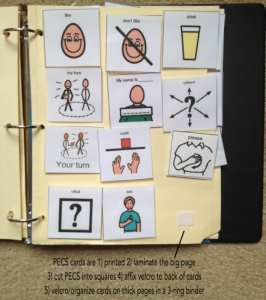 The Picture Exchange Communication System (PECS) uses picture cards to communicate. It’s a great way to encourage/teach non-verbal kids to start communicating by pointing at the cards. Here is a pdf of our actual PECS notebook for you to use as an example.
The Picture Exchange Communication System (PECS) uses picture cards to communicate. It’s a great way to encourage/teach non-verbal kids to start communicating by pointing at the cards. Here is a pdf of our actual PECS notebook for you to use as an example.
PECS begins by teaching an individual to give a picture of a desired item to a “communicative partner”, who immediately honors the exchange as a request. The system goes on to teach discrimination of pictures and how to put them together in sentences. In the more advanced phases, individuals are taught to answer questions and to comment.
The PECS teaching protocol is based on B.F. Skinner’s book, Verbal Behavior, such that functional verbal operants are systematically taught using prompting and reinforcement strategies that will lead to independent communication. Verbal prompts are not used, thus building immediate initiation and avoiding prompt dependency.
PECS has been successful with individuals of all ages demonstrating a variety of communicative, cognitive and physical difficulties. Some learners using PECS also develop speech. Others may transition to a voice output system. The body of research supporting the effectiveness of PECS continues to expand, with research from countries around the world.
You can make your own PECS at home by taking pictures with your phone (or from the internet), printing/typing the word underneath each image, cut into squares, laminate, cut into squares again. Put velcro on back and put into a notebook.
This webpage has even more PECS links for sourcing images and creating your own PECS.



Great post.